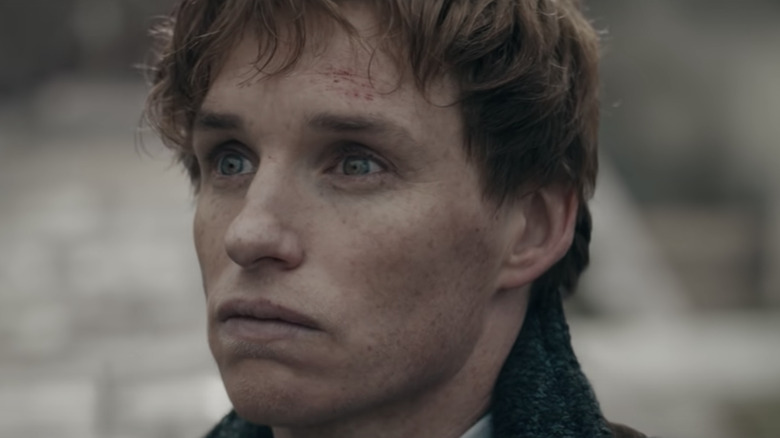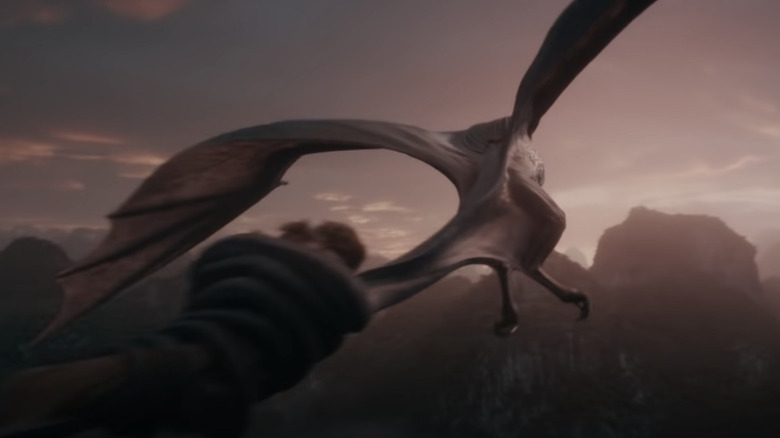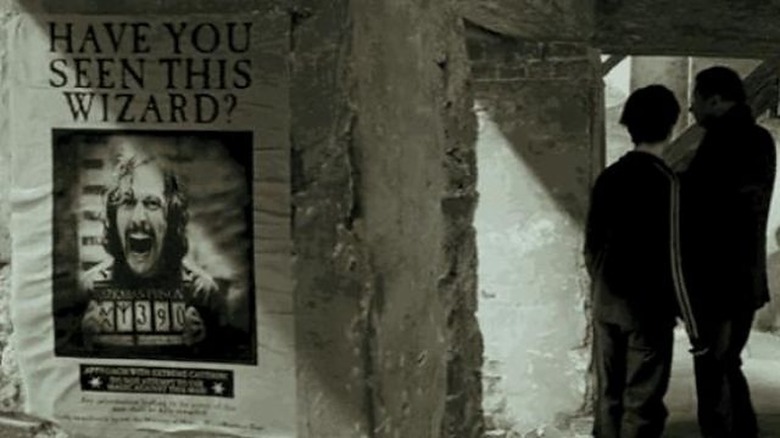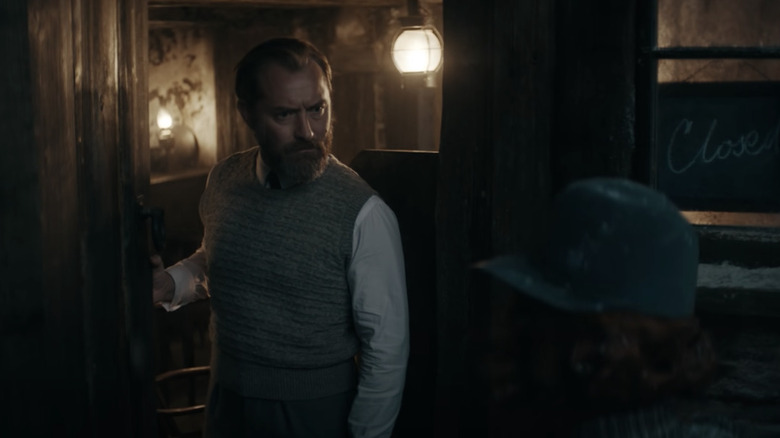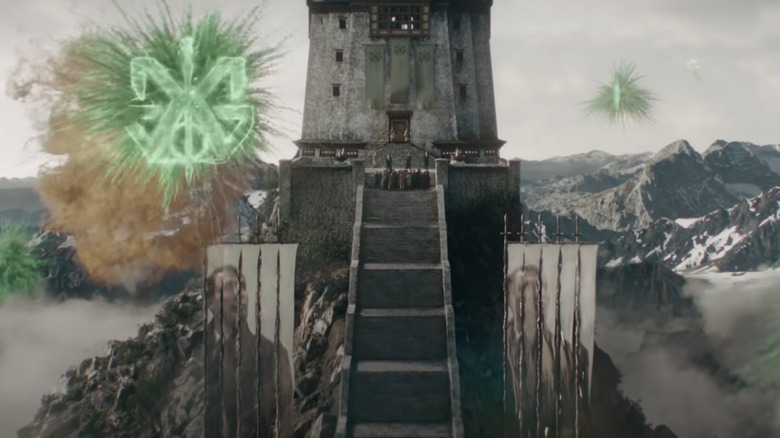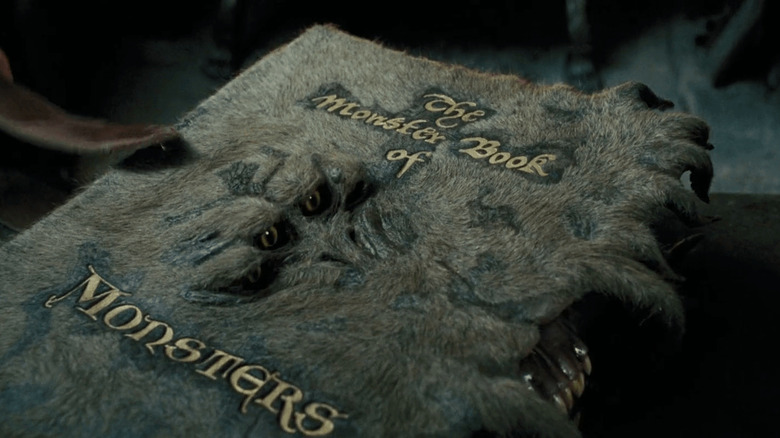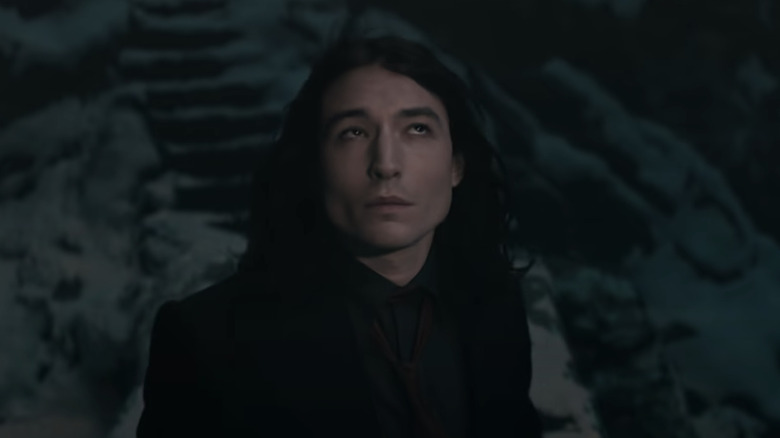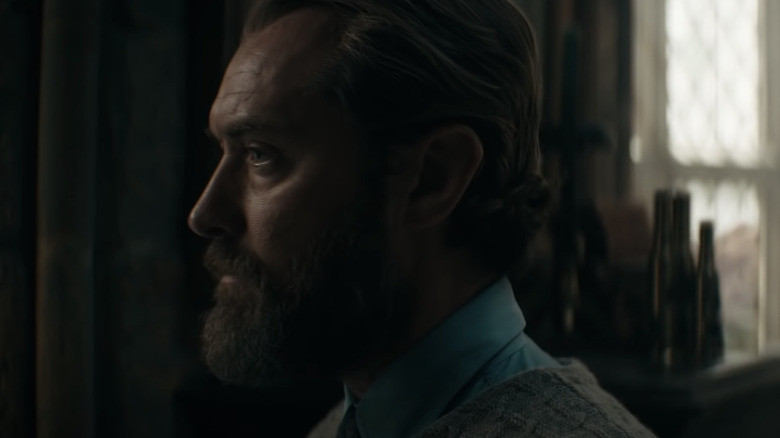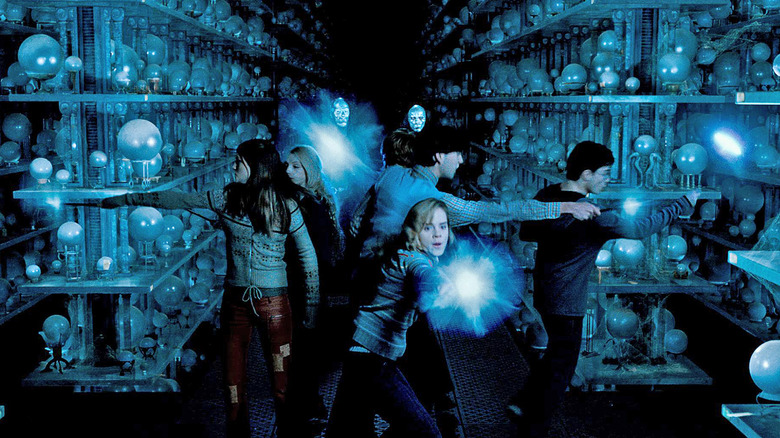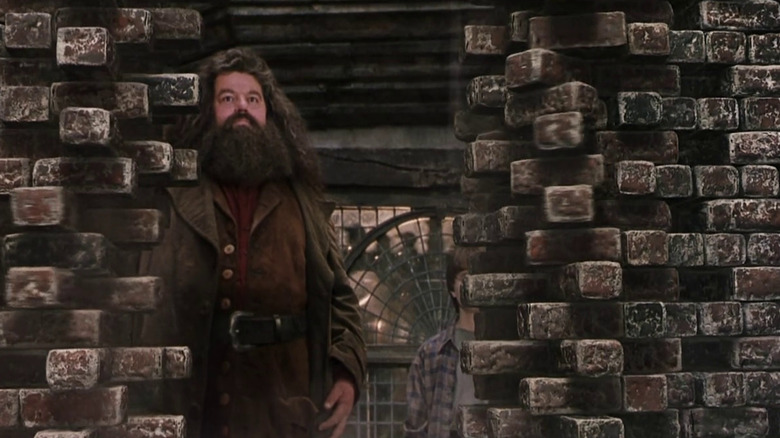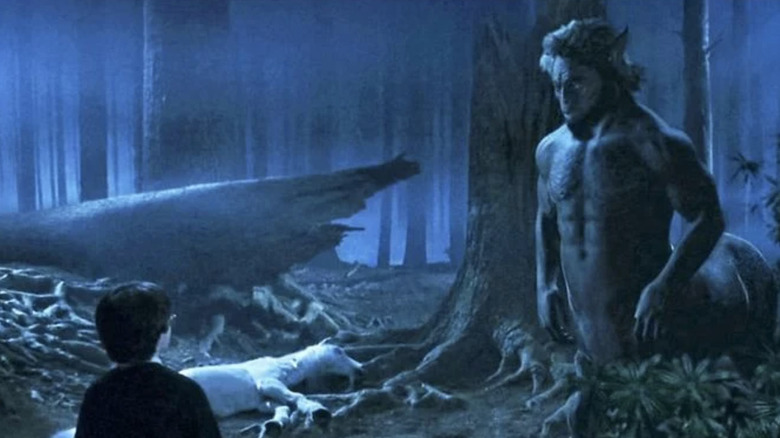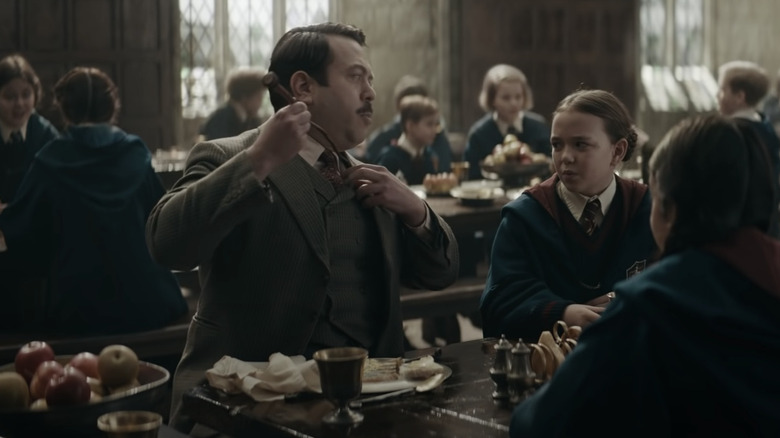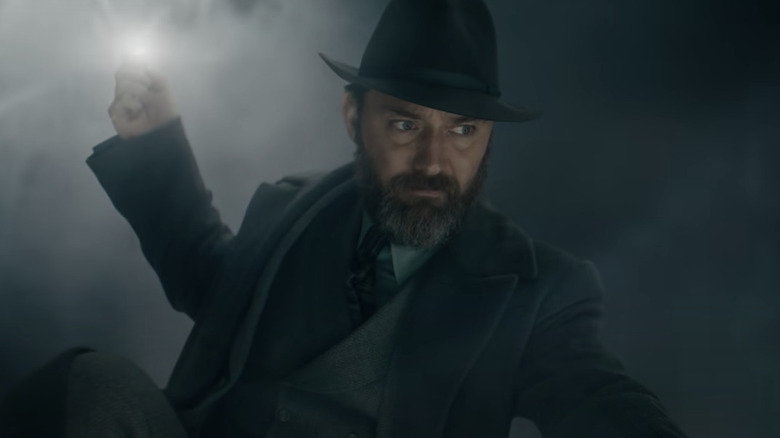Easter Eggs You Missed In Fantastic Beasts: The Secrets Of Dumbledore
There's no denying that "Fantastic Beasts: The Secrets of Dumbledore" brings the magic back to the Wizarding World. The "Harry Potter" prequel series has sometimes failed to find its footing between its fantastic beasts angle, depicting the rise of a dark wizard dictator, and piecing in magical elements and references that fans know and love from the original "Potter" books and movies. However, "The Secrets of Dumbledore" grounds itself in its pacing and plot to weave in these concepts more seamlessly than we've seen before in the series.
Fans likely have original "Harry Potter" screenwriter Steve Kloves to thank for that, who penned all but one of the original movies. Now, he's stepped in to co-write "The Secrets of Dumbledore" alongside the increasingly controversial J.K. Rowling.
Kloves signed on to bring the magical elements that fans loved best to the forefront of "The Secrets of Dumbledore," packing it to the brim with nostalgia without making the plot suffer. Between heading back to Hogwarts and Hogsmeade, paying homages to some of the original series' most iconic quotes, and dusting off a slew classic magical objects and symbols, the film has fun Easter eggs at every turn.
Newt's rescue
What is a wizard to do without a bird to save the day? Bring yourself back to 2002 when "Harry Potter and the Chamber of Secrets" released (or the 40 times you've watched the movie since then). Fans had just met Dumbledore's phoenix Fawkes, who played a significant role in Harry destroying Tom Riddle's diary and saving Ginny. While it may not seem too significant, Fawkes carrying Harry, Ron, Ginny, and even Lockhart out of the Chamber even made it onto the cover of the American version of the book.
Now, with the events of "The Secrets of Dumbledore," phoenixes are more integral to the plot than ever. However, it's not a phoenix that offers the "Chamber of Secrets" Easter egg. Toward the beginning of the movie, Newt faces off against Grindelwald's followers. Mirroring the Fawkes scene from decades later, a dragon-like creature called a Wyvern flies Newt, his suitcase, and his beasts away from the area as it puffs up like a dragon pufferfish. Not only does the moment bring in some of the areal flying shots that fans have missed, but it's a significant homage to the Fawkes — who might just be Credence's phoenix.
Wanted poster throwback
There's no denying that Sirius Black is one of the greatest characters to appear in the "Harry Potter" books and films. But he's also deeply misunderstood. Here is a man who's had his reputation obliterated by a supposed friend and was tortured in Azkaban for 12 years. Yet despite his deep trauma and the overwhelming depression he sometimes faces, Sirius Black still manages to be a good person.
In the movies, he tells Harry, "The world isn't split into good people and Death Eaters. We've all got both light and dark inside us. What matters is the part we choose to act on. That's who we really are." But between his wisdom and sadness, Sirius has an unparalleled zest for life and an infectious yearning for mischief. Basically, he's everything Grindelwald could be if he wanted — but the budding dictator chooses to kill people instead.
Much of the third "Harry Potter" film and movie hinges on the manhunt for Sirius, with Hogsmeade, Diagon Alley, and Hogwarts littered with moving Wanted posters. Well, "The Secrets of Dumbledore" is giving fans deja vu with Grindelwald's snowy Hogsmeade wanted signs. Fittingly, Grindelwald gets exonerated for the crimes he did commit, while Sirius must go into hiding until his death. Even in the wizarding world, life isn't fair. Grindelwald doesn't deserve the reference to Sirius in this way, but hey, a wanted poster is a wanted poster.
A nod to the Hogwarts Express
Who needs flying cars when you can have magical trains? Some of the "Secrets of Dumbledore" references to "Harry Potter" are pretty on the nose, but it doesn't make them any less charming. While the Wizarding World films often focuses on the beauty of humanity, they also encourage fans to appreciate the breathtaking beauty around them in nature. Though J.K. Rowling's decision for the Hogwarts Express stemmed from getting the idea for the series on a train (per Bloomsbury), the mode of transit uncovers the magic of Hogwarts before students even raise their wands.
"The Secrets of Dumbledore" had a similar idea, having Newt's ragtag group of misfits meet on a train while it flies through snowy mountains. It may be a fairly plain-looking train, but the homage to the Hogwarts Express is palpable. Of course, Jacob is also here to give us some "Anything off the trolley, dears?" vibes when he hits up the bar. However, instead of pumpkin juice, he's more interested in Gigglewater — don't drink this at home, kids.
Dumbledore paraphrases his future self
Dumbledore is known for his sage wisdom, and even when he's 50 years younger than when fans first meet him in the "Harry Potter" series, he doesn't disappoint. The future headmaster has gone through more than a few internal battles, fighting off his thirst for power and dominance in favor of trying to do the right thing. Dumbledore has long since ditched the "For the greater good" mantra he concocted with Grindelwald, but he still occasionally falls into that mentality.
For instance, Dumbledore basically raises Harry for the slaughter to take down Voldemort — even when he wasn't sure that his theory that Harry will survive would come to pass. Yet despite his many flaws, Dumbledore gives Harry some food for thought after Cedric's "Goblet of Fire" death. He says, "Dark and difficult times lie ahead. Soon, we must all face the choice between what is right and what is easy."
Of course, he's had a long time to perfect the sentiment between the events of "The Secrets of Dumbledore" and "Goblet of Fire." Yet he gives Newt a similar message to relay to Vogel, who holds Grindelwald's fate as a convict in his hands. So, what's the message? "Do what is right, not what is easy." Sounds familiar, no? Later, answering the question of why Grindelwald can run for Supreme Mugwump despite being a wannabe dictator, Dumbledore says, "Because Vogel chose easy over right." Apparently, Dumbledore was a bit pithier in his youth, but the sentiment is the same.
A subtle Deathly Hallows reference
Back in "The Deathly Hallows," Grindelwald and Dumbledore's past obsession with the fabled belongings of the Peverell brothers begins unraveling. Not only was Grindelwald himself on the hunt for the Elder Wand, the invisibility cloak, and the resurrection stone, but Dumbledore got wrapped up in the power search, too.
Up until this point in the series, Grindelwald's Hallows obsession goes relatively unmentioned — outside of the fact that he already obtained the Elder Wand from esteemed wand maker Gregorovitch. Yet it looks like the Hallows may play a greater role in Grindelwald's continued quest for domination over the muggle world. In "The Secrets of Dumbledore," fans learn that each wizard running for Supreme Mugwump has a symbol associated with them. Wizards cast their vote for the next leader by firing off their nominee's symbol from their wand.
In a blink-and-you'll-miss-it scene, it's clear that the Deathly Hallows symbol inspired Grindelwald's mark. The Hallows symbol lies in the middle of two Gs (for Gellert Grindelwald), with a more pronounced Elder Wand nestled distinctly in the middle. Along with the Hallows reference, the symbol is eerily similar to the Death Eaters' Dark Mark — right down to the lime green color. Did anyone else get some chills here?
Hagrid's favorite book
Harry's most traumatic moment in "Harry Potter and the Prisoner of Azkaban" may not be getting attacked by his werewolf professor and finding out his best friend was sleeping with a 40-year-old rat. No, it just might be when his Care of Magical Creatures book tries to eat him. When the students call out Hagrid for his bizarre and frankly violent choice of biting books, he doubles down on them being cute and instructs the students that they simply have to "stroke the spine" to prevent their textbook from beating them up.
As it turns out, the wizarding world isn't quite finished with "The Monster Book of Monsters." When Dumbledore's OG army sets off to confuse Grindelwald and get the Qilin to the election, all but one group member carries a bewitched suitcase that looks like Newt's. One has a golden snitch (which gives off Dumbledore's "Deathly Hallows" will vibes), another has pastries, and one melts — to name a few.
Of course, there's also one with colorful textbooks, designed mainly by real-life artist MinaLima. Some of the titles include "Sonnet of a Sorcerer," which jinxes readers into speaking in limericks forever, "Have a Fiesta in a Bottle," and "Extreme Incantations." But alongside the colorful creations is the dreaded "The Monster Book of Monsters," which means that Harry's textbook is quite old. It may have even been released before Newt's book "Fantastic Beasts and Where to Find Them." However, judging by the cover (sorry, librarians everywhere), the book likely paints creatures in a much more negative light than Newt's guide.
Always
If there's one thing the "Fantastic Beasts" series doesn't need, it's romanticizing Severus Snape's incel behavior toward Lily Potter. Yet like its predecessor, the franchise just couldn't help itself. In "The Deathly Hallows," fans learn about Snape's obsessive "love" for Lily through Snape's memories. Sure, Snape turned his back on Voldemort, but only after the dictator killed Lily — Snape was fine with her family getting murdered, as long as she survived.
Snape's pining over the woman who turned him down decades ago is endless and ridiculous, to the point where he bullies her child (just because Harry looks like James), and Snape's Patronus is still a stag to match Lily's. When Dumbledore asks if he loves Lily after all this time, the potions master says, "Always." In reality, the quote symbolizes Snape's unwavering stalker behavior, but even Harry himself romanticizes Snape's actions when he names his second son Albus Severus.
Meanwhile, in "The Secrets of Dumbledore," following the reveal that Credence is Aberforth's son, it's unclear why Aberforth never bothered to look for him. It's pretty negligent on Aberforth's part, given that it seems like he suspected or fully knew of his child's existence. When Credence finally meets Aberforth, he asks, "Did you ever think of me?" Paying homage to Snape, Aberforth says, "Always." Aberforth tells Credence to come home, only taking responsibility as a father when his son is dying — and there's nothing that can save him. In some ways, Snape and Aberforth are alike. So while the homage is fairly annoying when you hold Snape accountable for his actions, it's not entirely unfitting.
Dumbledore's pocket watch
Okay, Dumbledore, keep your secrets. There's no better title for the third installment of the "Fantastic Beasts" series than "The Secrets of Dumbledore." Why? Because the guy is harder to read than a hexed poetry book. He keeps almost everything to himself until the point in which he decides that he needs to clue in the people helping him, and not a minute more. As a result, he has a wealth of knowledge about the wizarding world that he keeps quiet, along with more than a few wickedly powerful gadgets that he either procured or created himself.
One such gadget takes the form of a stopwatch. The first "Harry Potter" book describes it as "A very odd watch. It had twelve hands but no numbers; instead, little planets were moving around the edge." Dumbledore uses it to tell time, and it makes an appearance in the first and fifth books. However, it never shows up onscreen until the "Secrets of Dumbledore." Here, Dumbledore clearly uses the pocket watch to find Credence's location, and he has a picture of the wizard on the stopwatch. It's no surprise that the mysterious-looking watch would have a use beyond telling time, but it's unclear if it works to track down just anyone or if it's a Dumbledore heirloom specifically made to keep tabs on his bloodline. Either way, it's fun to see an aspect of the book come to life onscreen for the first time.
Prophecy time
The Department of Mysteries is, well, a bit of a mystery. Back in "The Order of the Phoenix," Harry and a select few of Dumbledore's Army head to the Ministry of Magic to take on a nasty group of Death Eaters — and Voldemort himself. Of course, Voldemort lures Harry in with a false vision of him torturing Sirius. The film's storyline hinges on prophecies and the revelation that Voldemort sealed his own fate by choosing to go after Harry as a baby when the prophecy could have just as easily referred to Neville. So, why exactly does Voldy need Harry to listen to the last portion of the prophecy? Well, someone spells the prophecies so only the subjects and the seer who foretold the events can pick up their prophecy.
In a small and seemingly insignificant scene in "The Secrets of Dumbledore," Lally spells what looks like a ton of prophecies in the buildup to the big election sequence as a distraction technique. They could just be orbs with no relation to prophecies, given that no prophetic sequences play, but nevertheless, it's a fun nod to the fifth installment of the original franchise.
Brick by witchy brick
The wizarding world is chock-full of secret passageways and unique ways that the magical community separates their world from that of their muggle counterparts. The entrance to St. Mungo's hospital, for example, exists in a seemingly abandoned building called Purge and Dowse Ltd., with an old dummy as the hospital's gatekeeper. Meanwhile, Hogwarts has a protection spell that causes muggles to see a danger sign atop ruins. Not all modes of secrecy are winners, though. At the Quidditch World Cup in "The Goblet of Fire," any muggles who witness magical activities at the muggle campsite leave with the parting gift of an obliviate spell. Instead of creating a barrier spell, the wizards chaotically make muggle passerby forget they ever say magically charmed tents and people flying on broomsticks.
When it comes to the entrance to Diagon Alley, though, Hagrid shows Harry how to enter without apparating or floo powder. He simply taps a combination of bricks, and the wall opens up. We haven't seen this method of entry in any other magical location since then, but "The Secrets of Dumbledore" brings it back when Dumbledore's original army goes to the German Ministry. The bricks are just a tad bit sleeker, but the gist is the same.
Shoutout to the centaurs
Centaurs are an integral part of the "Harry Potter" mythos, but despite the "Fantastic Beasts" series being about, well, fantastic beasts, the half-human/half-horse hybrids have yet to make an appearance in the franchise. On the one hand, it makes sense. Centaurs are incredibly proud beings who don't often embroil themselves in wizarding affairs. Firenze makes an exception for Harry, and he basically gets excommunicated for it. Keep in mind that Voldemort's plans for creatures were just as abysmal as they were for muggle-borns, and the centaurs had just as much to lose as the wizards in that fight.
Yet despite having their own stakes in the fight against Voldemort, they still wanted nothing to do with the wizarding world. So it's no surprise that they're not lowering themselves to dealing with Grindelwald's drama. Although the centaurs aren't gearing up for battle against Grindelwald, "The Secrets of Dumbledore" finds a way to incorporate the prophetic creatures anyway. A centaur is painted on the building where Vogel makes excuses for letting Grindelwald run for Supreme Mugwump and acquitting him of his crimes. Vogel notes that if the people don't have a chance to vote for the dictator, the streets will run with blood. Yet they'll run with blood anyway, and like the centaurs, his inaction will prolong the war.
Cockroach clusters
Fans who haven't tricked their best friends with some particularly nasty Bertie Bott's flavors are missing out on a whole new level of cunning prank wars. Honeydukes may be chocolate-full of a wide assortment of delicious-sounding candy and treats, but some of their options sound downright disgusting.
Take blood pops, for example. Who on earth would want a lollipop that tastes like blood? Vampires aren't exactly the target clientele of Honeydukes, after all. For the discerning wizard who wants to literally burn a hole in their tongue, what better option is there than an acid pop? However, most horrifying of all are the cockroach clusters — peanut-type candy made of, you guessed it, cockroaches. As anyone might suspect, these bizarre "treats" are purchased more often to troll unsuspecting Hogwarts classmates than to actually eat.
Ron fails to trick Fred into eating them, and as it turns out, the Slytherins in "The Secrets of Dumbledore" have a similar idea. When Jacob hangs out in the Great Hall, some "nice" Slytherins offer him candy. When Dumbledore says he never cared much for "Cockroach Clusters," Jacob serves the Slytherins with a betrayed glare. Yet despite Dumbledore's distaste for cockroach clusters and earwax Bertie Bott's, he chooses "Cockroach Clusters" as a password for his office about 50 years later. Maybe he just misses his Muggle friend.
Dumbledore vs. the Deluminator
Dumbledore's use of his deluminator, a light-sucking magical object of his own making, is the initial scene fans witness in the first "Harry Potter" film. For a while, it simply seemed like the object could only suck up and release the light from various light sources — Lumos and Nox be damned. Yet in "The Deathly Hallows," Ron inherits the deluminator from Dumbledore. Not only does the object control light sources, but it seems to be a listening device, too. After Ron bails on Harry and Hermione during their Horcrux search, he hears snippets of conversations from the object when Harry and Hermione mention his name. Even weirder, it acts like a Portkey to bring Ron back to his friends when he realizes leaving was a mistake.
The full extent of the deluminator's powers is never fully explored in the original books and movies, but "The Secrets of Dumbledore" lends some insight into this matter. Dumbledore seemingly uses it in his battle with Credence and later Grindelwald, where the object does something very peculiar. It almost seems like the deluminator takes both sets of dueling wizards to a parallel plane adjacent to the real world, but it looks like a darker mirrored version. It seems like people on the physical plane can't see what happens during this duel, but the deluminator scenes go by so quickly and without explanation that it's hard to tell. However, one thing's for sure: The deluminator has quite a few tricks up its sleeve — and so does Dumbledore.
